What to look for when buying an 1100 in Australia.
Time has shown the 1100 to have a number of weaknesses which have no doubt contributed to its low survival rate.
Body rust and mechanical failures in the powerunit are the two major problem areas but on the other hand, the hydrolastic suspension has proven to be relatively trouble free in service. Australia's generally warmer climate places a different emphasis on the various areas that an 1100 deteriorates compared to that of its counterparts in the UK, so the following outlines some of the main areas to be aware of.
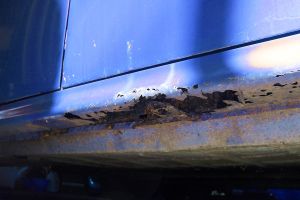 The sills
which run along the length of the car (below the doors) are
notorious for rusting but thanks to our relatively dry, mild
winters the rust is usually confined to the outer
sill.
The sills
which run along the length of the car (below the doors) are
notorious for rusting but thanks to our relatively dry, mild
winters the rust is usually confined to the outer
sill.
This area rusts because dust and water find their way inside the sill allowing rust begin from within. It is not unusual to find some rust in the outer sill but it is rare to find it as bad as in the picture opposite. Even this car had sound inner sills with just some surface rust.
Any previous repairs are likely to be a proper replacement sill panel as opposed to the "cover sill" repair often referred to in the UK.
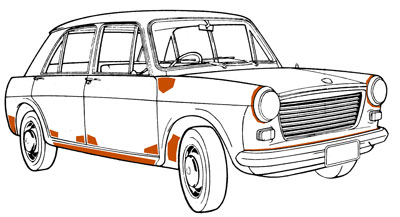 The boot floor , especially at each end below
the tail lamp assemblies often rusts out if either the boot
rubber seal is perished or the rear windscreen rubber is leaking.
Water will collect at the lowest points and slowly rust through.
The boot floor , especially at each end below
the tail lamp assemblies often rusts out if either the boot
rubber seal is perished or the rear windscreen rubber is leaking.
Water will collect at the lowest points and slowly rust through.
The front cabin floor area can also become quite rusty as the jute soundproofing material just soaks up water and the rubber mats tend to trap the moisture there. Water can leak in around the windscreen rubber if the sealant has dried out, or much worse, if the heater's freshair intake chamber has become clogged with dirt and leaves thus blocking the water drain holes then there may be rust holes through into the interior of the car and in the pillars where the front door hinge.
The top corners of the front mudguards near the windscreen and around the headlamps can collect mud and this can lead to rusting in these areas too.
Mechanical problems.
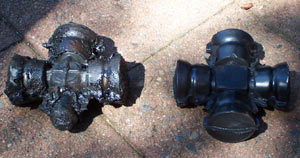 One major point to check concerns the inner universal
joints where the drive shaft joins the gearbox.
One major point to check concerns the inner universal
joints where the drive shaft joins the gearbox.
All manual transmission models (with the possible exception of some towards the end of production) left the factory fitted with joints of the rubber cross type, however it is not unusual for the rubber type to have been replaced with the more robust all-metal bearing type particularly on 1100 S models.
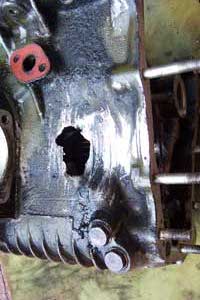
There are a number of things that can happen with these
if they are not replaced when they show signs of deterioration.
Oil leaks can cause the rubber to swell and in the case if the right hand joint, it can begin to rub against the side of the gearbox and slowly wear away the soft metal to the point where you have a hole in the side of the gearbox/sump.
If the rubber begins to perish and come away, the metal core of the cross will be forced to flex and move about more than intended and eventually it will snap.
If this happens on the right hand side joint it will almost certainly punch a hole in the gearbox when it eventually snaps.
Oil Leaks.
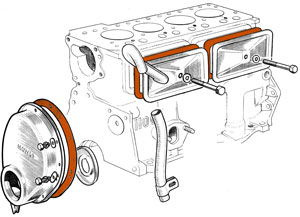 As the engine and gearbox share a common lubrication supply,
there are numerous places where oil leaks can develop.
Some are easily fixed, others can be fixed with the engine in car
and some require the power unit to be removed. The annual
roadworthiness inspection in NSW requires no oil to be dropped onto
the roadway. The following is a guide to the ease of fixing leaks from various locations
As the engine and gearbox share a common lubrication supply,
there are numerous places where oil leaks can develop.
Some are easily fixed, others can be fixed with the engine in car
and some require the power unit to be removed. The annual
roadworthiness inspection in NSW requires no oil to be dropped onto
the roadway. The following is a guide to the ease of fixing leaks from various locations
- The easily fixed leaks are those originating from the rocker cover, the pushrod covers at the back of the block and the detent plunger plugs on the sump.
- Leaks from the timing chain cover can be fixed with the Engine in the car but it requires the removal of the radiator and the crankshaft pulley.
- A leak from where the engine joins the gearbox or from the final drive assembly will need the whole power unit removed.
 Any 1100 that has spent years parked in the
sun will have discoloured interior trim - particularly those originally green, red or beige.
The yellow pigment in the door and seat vinyl and the rubber floor seems to fade quickly turning green interiors blue
and beige interiors to grey, while red seat vinyl tends to darken becoming almost maroon.
Any 1100 that has spent years parked in the
sun will have discoloured interior trim - particularly those originally green, red or beige.
The yellow pigment in the door and seat vinyl and the rubber floor seems to fade quickly turning green interiors blue
and beige interiors to grey, while red seat vinyl tends to darken becoming almost maroon.
 Check the colour of a section of the trim that has been hidden from sunlight - you might be suprised at what you find, particularly on a green car with blue seats...
Check the colour of a section of the trim that has been hidden from sunlight - you might be suprised at what you find, particularly on a green car with blue seats...
Apart from discolouration, the seat vinyl dries out and cracks particularly the top edge of the backseat. The rubber webbing in the front bench seat stretches and dries out too causing the foam padding to sag. Replacing this webbing - often known as "Pirelli webbing" - is within the scope of an experienced handyman and it is available from Hardware stores and rubber supplies outlets. Alternatively, an automotive upholsterer can do it for you.
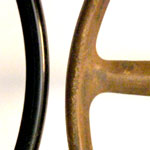 Other possible casualties of the sun are the
steering wheel, the horn button, the instrument panel surround and
the headlining material.
Other possible casualties of the sun are the
steering wheel, the horn button, the instrument panel surround and
the headlining material.
- The steering wheel not only fades but the plastic becomes chalky and flakes away. In extreme cases it can crack right through to the metal frame.
- The horn button (and the bonnet emblem for that matter) is made from clear plastic which develops a myriad of tiny internal cracks after not much time at all. A crack-free "new-old-stock" example developed many, many cracks after only 6 months on the my car...
- The headlining is a vinyl/foam laminate and is glued directly to the underside of the metal roof. The thin foam layer does little to shield the vinyl from the searing temperatures that the metal roof can reach on a hot day and the vinyl dries out and shrinks, splitting into thin strips along the grain of its backing material.